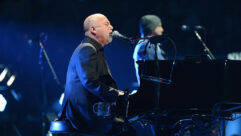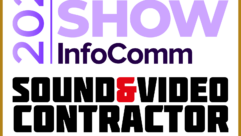
Mixing Live with RML Labs’ Software Audio Console, Part 1
May 3, 2012 9:59 AM,
With Bennett Liles
Listen to the Podcasts
Editor’s note: For your convenience, this transcription of the podcast includes timestamps. If you are listening to the podcast and reading its accompanying transcription, you can use the timestamps to jump to any part of the audio podcast by simply dragging the slider on the podcast to the time indicated in the transcription.

The Software Audio Console displays at the Goodlettsville Church of the Nazarene.
Digital mixers are getting more computerized all the time, but the price tags are pretty high, so why not just mix with a computer? At the Goodlettsville Church, Keith Sealy is doing just that and doing it live. He’s here to tell us about how it all works, next up on the SVC Podcast.
SVC: Keith, thanks for being with me on the SVC Podcast from the Goodlettsville Church of the Nazarene up near Nashville, Tenn. You’ve got something interesting going on there with mixing live on a computer, and I know the Goodlettsville Church is probably in the same position that a lot of other churches are in—trying to go digital and then they get sticker shock when they see the price tag on some of this stuff. So how about describing the Goodlettsville Church of the Nazarene. What sort of worship style do they have there?
Keith Sealy: Ok, we are a church that we average just over probably 500 people each week. We’re doing two services. It’s probably more of a contemporary service, but we still do some hymns and things like that, but it probably leans more towards the contemporary side of things. [Timestamp: 1:27]
OK and you’ve got some live music going on?
Yeah, we have a live band, full choir, occasionally we’ll do praise team. Some other events we do is we do some community events where we’ll do like 70’s theme music or 80’s theme music things of that nature. [Timestamp: 1:45]
Oh, well that sounds fun. At least it would be for me. I don’t know about the age demographic, but I guess that sort of appeals to different age groups.
For those services, typically we get a whole lot of community involvement and to be honest with you, we get some people that come normally to our church to come to those things, but we get more community involvement in those which is the point in the whole, the whole thing actually. [Timestamp: 2:07]
Right, get more people involved in what’s going on there. So what was the situation that kind of got the ball rolling and got you started looking for a mixer upgrade?
Part of the reason is because the system we had was getting well on up in age as is a lot of our equipment. We’re like a lot of churches where budgets are tight. We had an old Crest Century console, Century GT, which was a great audio console, but it was just becoming intermittent with us. We were starting to have some patching problems with it, some mic pre issues, and because of the multiple events that take place, we were really wanting to get to a digital format of some type so we can recall easily because it was always challenging trying to get back for Sunday morning after doing a totally different show on Saturday night or something. [Timestamp: 2:52]
Yeah, that seems to be one of the big draws on digital stuff for churches because you’ve got a lot of volunteer people and you need to have gear that’ll let you just push a button and get right back to where you were.
It’s a big seller. And I guess the church sound and camera and lighting jobs are pretty much handled by volunteers?
We run around 500, so we don’t have a lot of volunteers. We don’t really do any video per se. We have a camera, a single camera, that records our services but most of our volunteers are just for like a screen presentation and audio. So we have about four or five people that we rotate. [Timestamp: 3:25]
OK, well not that many, but that probably makes it easier to keep track of and know what everybody’s doing at least with a smaller bunch.
Not that we’re not trying to include more people, but it’s also easier to stay consistent from Sunday to Sunday. We have good people working in those areas. [Timestamp: 3:39]
Mixing Live with RML Labs’ Software Audio Console, Part 1
May 3, 2012 9:59 AM,
With Bennett Liles

The business end of the Software Audio Console control point at the Goodlettsville Church of the Nazarene.
And with a smaller group of volunteers on the tech jobs, it’s got to be easier to handle training and breaking people in on the various tech positions.
Yes, yeah, very much so. A lot of times for training what I’ll do is I’ll sit down with them and just kind of show them what we’ve got and then for the first couple of weeks we’ll have them sit with an operator that is used to running the equipment and that way they can see how it actually happens in the actual service because a lot of times in training you don’t actually see things that might take place in the service and it’s good for them to just sit and ask questions while the service is going on. [Timestamp: 4:12]
Right. No substitute for being there and watching everything happen right in front of you and being right in the middle of it all.
Exactly.
What made you decide to go with the Software Audio Console that you finally got with on this for actually doing live sound mixing?
Well, to be honest with you, cost had a lot to do it. We were looking at some of the other digital consoles. I have worked on many other digital consoles because I’m kind of a freelancer when I’m not here at this church working. I’m a freelancer audio engineer and so I’ve worked with a lot of the digital consoles. So I kind of had an idea of what was out there, but I also knew the cost of those digital consoles and I knew that it would be a stretch for us to afford something like that for the size that we needed because we were looking to go a minimum of 48 inputs. So the price of the Software Audio Console when we sat down and started figuring out we were able to go 48 inputs, 48 outputs for around $6,000, so that was a big seller for us and it still worked. It wasn’t something that was very difficult to use. [Timestamp: 5:12]
That would most likely be sort of a sticking point in the minds of a lot of experienced audio people on this. Sure it’s pretty inexpensive, but how well does it work especially when you’re doing live music without having a big console in front of you.
Yes, yeah, it’s a little different. I’ll admit that, but like I said I come from a world of different audio consoles and I’m used to working in Pro Tools, which a lot of people are with and that’s working on a computer with a mouse basically. But thing that’s nice about the Software Audio Console is the way it’s laid out they give you 16 DCA groups so you just have to get it laid out for your situation and a lot of Sundays we typically have the same band, same choir. You know, we’re not changing a lot really quickly at any one time. It would be more difficult, I think, for people that are maybe doing, you know, fairground type stuff where they got a different act coming in one right after the other where things are changing a lot but for us that’s not the situation and for our situation this worked well and we find that we typically stay on the DCA groups page and then the way our setup is we have another page that shows all of our inputs so if we need to get something quick we can. So, it’s wasn’t too bad but it is a little bit different. It’s something you have to get used to. [Timestamp: 6:28]
And when you’ve got everything lined up there, what sort of sources are you dealing with? What kind of instruments does your band have?
We’ve got full acoustic drum set, bass, electric, a lot of times we’ll have a couple of acoustic guitars, keyboards, piano, full choir and vocals to go on top of this. So we’ll run somewhere, on any given Sunday, we’ll probably run around 40 inputs or so by the time you count playback from computers and things like that. [Timestamp: 6:54]
Well, even with a front line digital board that would be pretty much a handful, especially for people who are not used to it.
Exactly and you know comparing it to other digital consoles, I feel like it’s as easy to get around on as some of the other ones that are out there. I’ve worked on the Yamaha, MC7 and even the Roland digital and you get buried in pages real quick on those consoles and that’s something that really you don’t get caught up in on the Software Audio Console because another way they have it laid out is you can assign function keys that will change your display, will take you to different places so once you figure out what your function keys are within the hit of a button you can be there. [Timestamp: 7:34]
So when you first got this idea of going with a Software Audio Console did you have a local guru somewhere or where did you go for advice or help with it?
I’ll tell you the way it came about is we have a gentleman in our church, his name is Tony Morgan, and Tony does audio for the country group Diamond Rio and he was telling us that Diamond Rio recently switched over to this new audio system because we had been talking about we kind of wanted to get into the digital world so he said, “Hey look, you need to check this out. It’s working really well for us.” So we were able to talk to him and he was a big help in just pointing us in what we needed to look at—made it available that we could come see their system and then also the Software Audio Console has a great forum you can go to and you can get a lot of questions answered on their website. [Timestamp: 8:21]
Well, as long as it’s just audio people talking back and forth it’s probably easier to get on the same wavelength, but how did you deal with the church staff? How did they react to the idea of using the Software Audio Console for mixing live stuff?
You know, I’m probably in a unique situation in that our church board and staff, they really leave decisions like that up to me and they trust me with it and that’s not to pat myself on the back or anything, but we’ve got a pretty good track record of making smart decisions. So I had mentioned it to them that, “Hey, this is something we’re looking at,” and with any church board, when you say, “Hey, it’s only going to cost me $6,000 versus $30,000,” that’s a pretty easy sell and so we really didn’t have any kind of problem at all selling it to our staff and board. [Timestamp: 9:04]
Right, even if they don’t know all the in’s and outs of digital audio, they understand the price tag.
Absolutely and that was a big selling point.
What do you use to physically interface the sound sources with the software?
You can use any mic pre you want, you can use pretty much but we chose to go with the Behringer. I believe they’re the ADA8000’s, and they’ve got the eight mic pres built in and then they have the optical in and out on them. So we chose those and like I said, we’re doing 48 in, 48 out, and they delivered that and then from there it goes to the Motu 2408 to get the actual audio in and out of the computer system. [Timestamp: 9:39]
Yeah, on the Motu I believe you can actually do SMPTE sync on that.
Yes, you can SMPTE sync and I know a lot of the—one of the other places when we were looking at this if you go to YouTube some shows out in Vegas are using it and pretty much let it run on its own to control different lighting scenarios and things like that because it can generate time code or it will receive it also they tell me. [Timestamp: 10:01]
I saw some of those videos and some of those are really interesting. I was going, where’s all the big stuff and it’s just one guy sitting out there with a monitor.
Yeah, exactly.
OK, well, Keith Sealy. Thanks very much for being with us from the Goodlettsville Chuch of the Nazarene in Tennessee, and in part two we’ll get more into the Behringer BCF 2000 and some of the particulars on the computer you use for this and we’ll be seeing you then.
Thanks for joining us for the SVC Podcast with Keith Sealy of the Goodlettsville Church of the Nazarene. Show notes can be found on the website of Sound & Video Contractor Magazine at svconline.com. In Part 2 Keith gets into the Behringer BCF 2000 and plug-ins for the Software Audio Console, next time on the SVC Podcast.










